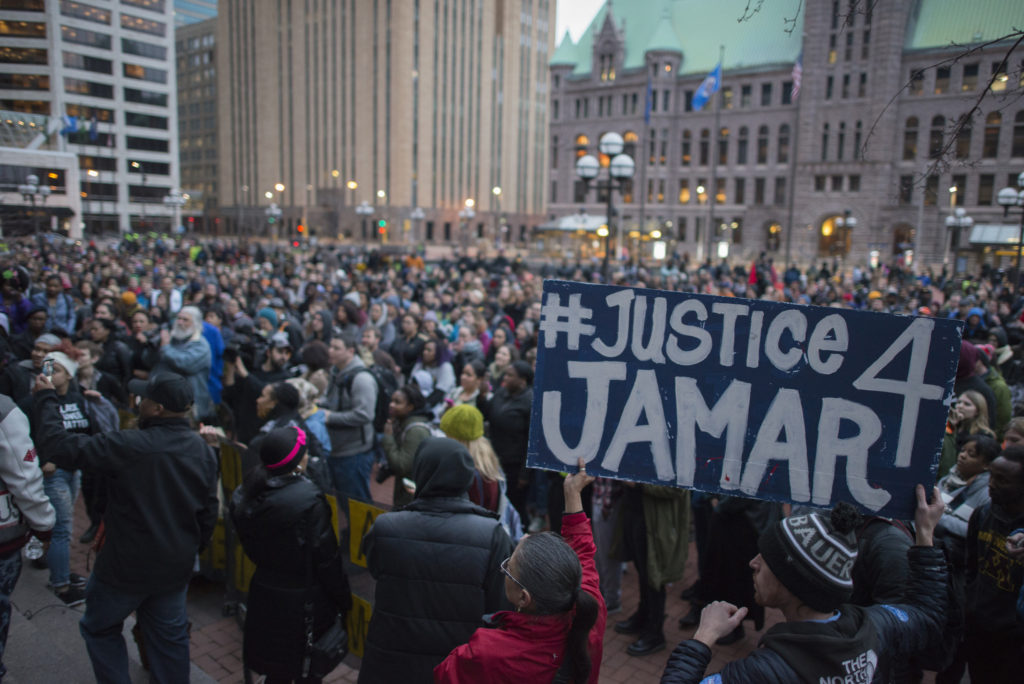Originally published at MintPress News.
MINNEAPOLIS — After the weekend shooting of an unarmed black man in Minneapolis, protesters camped overnight in a local police station, saying that they won’t leave until they receive justice.
Jamar Clark is on life support after the shooting, which took place early Sunday morning at the intersection of James and Plymouth Aves. in North Minneapolis. Numerous eyewitnesses at the scene, some of whom can be seen shouting on in a YouTube video uploaded on Sunday, claim that Clark was handcuffed at the time of the incident, though police deny that this was the case:
Like many other major cities, Minneapolis police have paid out millions in lawsuits over police conduct in recent years. In October, the city settled a lawsuit for $122,000 regarding a 2012 incident in which police allegedly assaulted a black man over a gun he was legally permitted to carry.
“This is a part of a pattern of police abuse that’s been going on for decades in the city of Minneapolis,” said Nekima Levy-Pounds, a civil rights lawyer and the president of the Minneapolis chapter of the NAACP, in an interview with MintPress News on Monday. She also highlighted the cases of Terrance Franklin and Tycel Nelson as other high-profile examples of what she called “execution-style killings” by police.
According to official reports quoted in the Minneapolis Star-Tribune, Clark, who was suspected of assault, “was shot on a north Minneapolis street by a police officer early Sunday while allegedly hindering emergency responders from aiding [Clark’s] victim.” Levy-Pounds said Clark got into a verbal argument with the driver of an ambulance containing his girlfriend shortly before police arrived and shot him.
She told MintPress said that a sizable crowd had gathered at the scene before the shooting, and what they describe differs significantly from police accounts. According to eyewitness accounts, a police officer “put him in a chokehold and brought him to the ground, another one put his knee in his chest.”
She says she was told that “an officer stood over him and shot him in the head” after Clark was handcuffed.
She said many people at the scene believed Clark was already dead when he was put in the back of an ambulance. As tensions grew in the aftermath, there were also reports that police used pepper spray and threatened protesters with guns drawn.
Speaking for her organization, Levy-Pounds said:
We have a number of concerns about the execution of Jamar Clark by Minneapolis police, and the conduct of the officers toward African-American community members who witnessed the incident, and we also have concerns about what we feel is a cover-up by the Minneapolis Police Department.

An outraged community responds
On Sunday, activists organized by Black Lives Matter Minneapolis gathered at the intersection where Clark was shot. From there, they marched on the closest police station, Minneapolis’ Fourth Precinct.
Levy-Pounds said the Minneapolis chapter of the NAACP supports the activists and that many of the group’s members joined in the march and subsequent protests.
Activists hung a “Black Lives Matter” banner over the police station’s sign, and protested around the building for several hours, at one point engaging in a tense stand-off with police after it was reported that an officer had drawn a gun on two women who attempted to enter the precinct in search of a bathroom. On Monday, tents were pitched in front of the station, Levy-Pounds said, and other Black Lives Matter activists were “cuddled up in blankets in the vestibule” of the station, refusing to leave until their demands are met.
The activists demand that police release the names of the officers involved in the incident. They also want to see surveillance video from an Elks Lodge located near the shooting, which many believe caught the incident on tape.
Under pressure from the community, the police have asked the Minnesota Bureau of Criminal Apprehension, a state-level law enforcement agency, to get involved. According to local independent journalist Sam Richards, the agency confiscated any evidence from the Elks Lodge and is refusing to release it to the media or the community:
This camera more than likely caught the shooting of #JamarClark. Building owners say BCA told them not to talk. pic.twitter.com/PeNHEV2n9y
— Sam Richards (@MinneapoliSam) November 15, 2015
The involvement of the BCA is a sign that community pressure is working, Levy-Pounds said, adding: “But we don’t trust Minnesota law enforcement agencies to hold each other accountable, because that rarely happens in this state.” As a result the NAACP and other community groups, including the ACLU, are demanding a federal investigation of the shooting.
In June, the Justice Department selected Minneapolis as one of six cities that would take part in its “Building Community Trust and Justice” program, which Levy-Pounds highlighted as evidence of the city’s serious problems with systemic racism and inequality.
“The Department of Justice’s own records show 40 percent of Minneapolis’ residents are of color, compared with 20 percent of the city’s police officers,” noted local news station KSTP in a report on the city’s receipt of the $4.75 million grant for the program.
Levy-Pounds added that beyond the disparity suggested by the statistics, the problem of police and community relations is exacerbated because most officers live in the suburbs and do not patrol in their own neighborhoods.
“We’re going to continue demand justice in the reform of policing practices in the city,” she said.
However, to achieve real justice, Levy-Pounds emphasized that the city must also address larger issues of racial disparity.
“The majority of African-Americans in this city live at or below the poverty line, are facing double-digit unemployment, and are concentrated in the poorest areas of the city where over-policing occurs,” she said, “and that’s part of what leads to a lot of the racial the tensions that we see happening between black residents and the police department.”